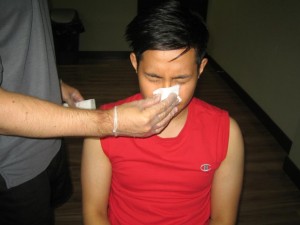Overview
A chemical burn happens when a fluid or chemical powder touches the eye. Normally, the injury occurs when a chemical splashes in the face. Though, chemical burns might also occur when you rub your eyes after working with a chemical product.
Always wear suitable protection goggles or a face mask when working with any form of chemicals. For non-toxic chemicals, like shampoos, rinsing the eye with some cool water is basically the only method you need. Though, splashes from toxic chemicals are severe and might lead to loss of vision. Get medical assistance as soon as possible.
Chemical Burn Symptoms

- Eye will start to sting
- A fiery sensation
- Rawness
- Pain
- Inflammation of the eyelids
- Fuzzy vision
First Aid for Chemical Burns to the Eyes
- Place cool water over your face for about 20 minutes. Gently spray your eyelids so the water can flow and rinse out the chemical (but be certain there are no toxic chemicals still on your hands).
- Take out contact lenses (if you wear contacts).
- Get medical assistance as soon as possible. The doctor or nurse must be informed with regards to the type of chemical.
- the amount of pain does not equate to how serious the injury actually is. For instance, alkali substances don’t generally cause noteworthy symptoms, but can really harm the eye.
How To Treat Chemical Burns
Treatment varies based on the chemical and the extent of the injury, but might consist of:
- Medication to relieve pain.
- Antibiotics to lessen the possibility of infection.
- Lotions applied to the surface of the eye to stop the eyelids from attaching to the cornea.
- Medication for anti-inflammatory.
- A patch can be worn over the eye until the eye gets better (for minor cases)
- Going to the hospital may be required and treatment is provided for any complications (serious cases).
Treating A Chemical Burn by Yourself
Be directed by your GP or healthcare expert, but common suggestions consist of:
- Driving your car while wearing an eye patch is not recommended.
- Use medicine precisely as instructed.
- Make sure you go to any follow-up appointments your GP has stated.
- See your GP or eye professional immediately if you have new problems, such as pain in any part of the eye, redness, or unclear vision.
Things To Remember
- A chemical burn takes place when a toxic chemical spills in your eye.
- Alkalis are particularly hazardous to the eyes.
- In many circumstances, quick and methodical cleaning of the eye (with a saline solution or cool water) radically decreases the possibility of injury and long-term injury.
- Always wear suitable protection goggles or face protection when dealing with chemicals.
